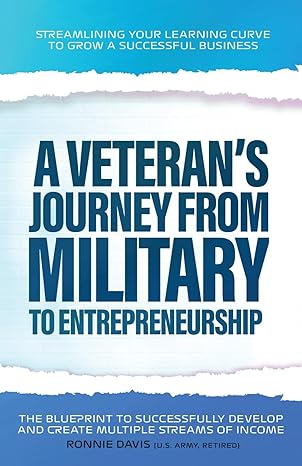Answered step by step
Verified Expert Solution
Question
1 Approved Answer
what are the issues and challanges related to performance measures in the nando's case study explain in brief. Abstract In late 2013, Nando's, a global
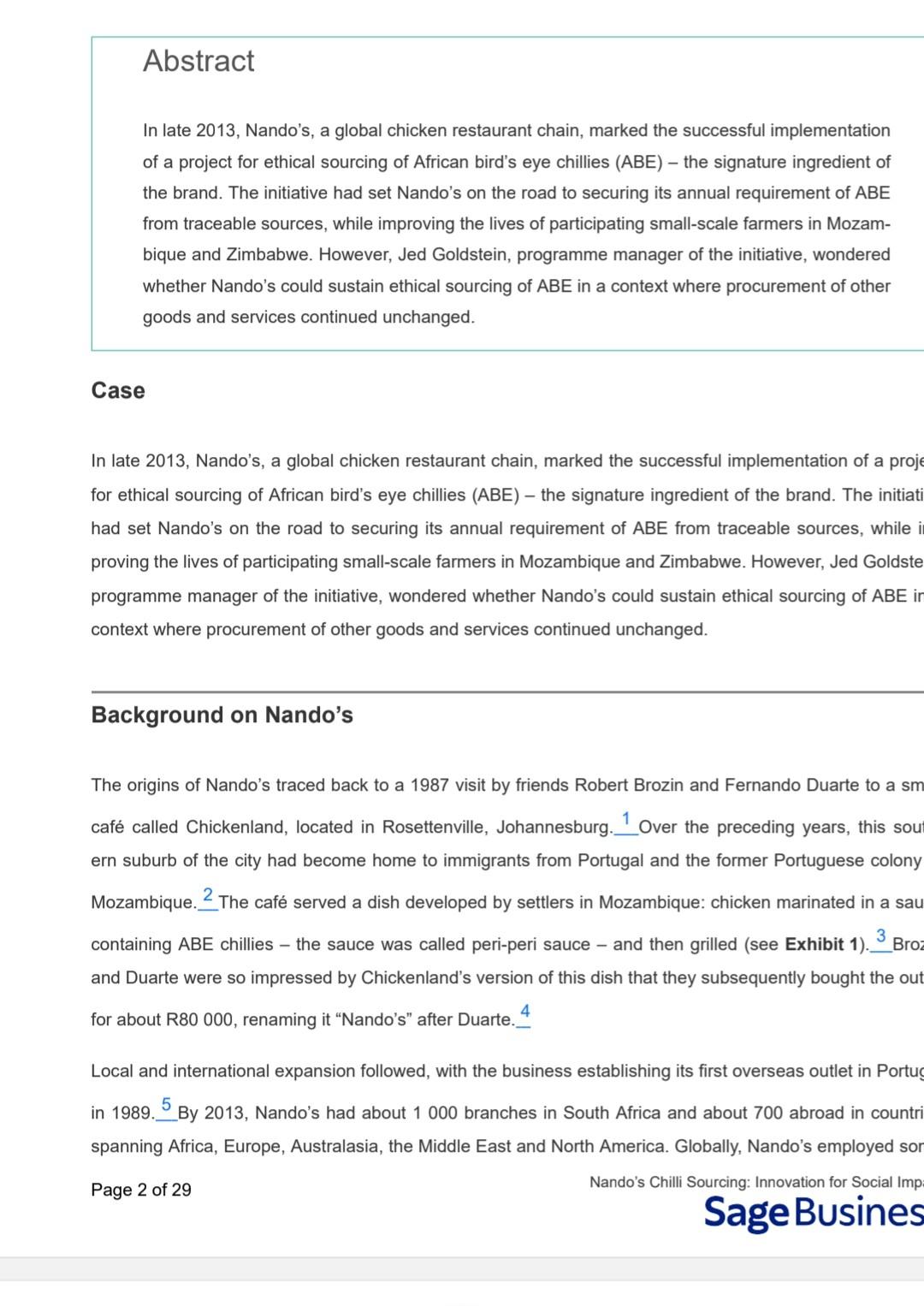
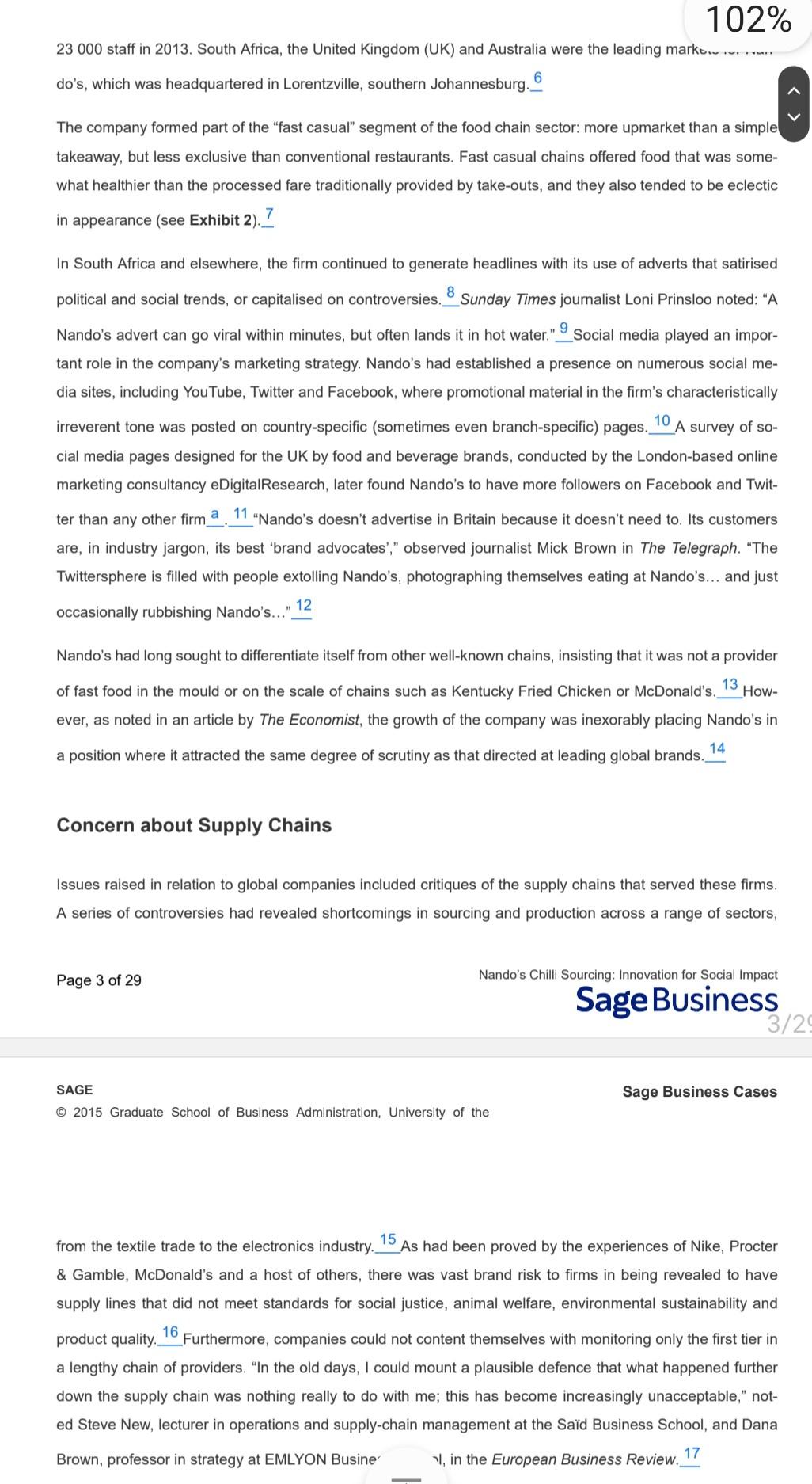
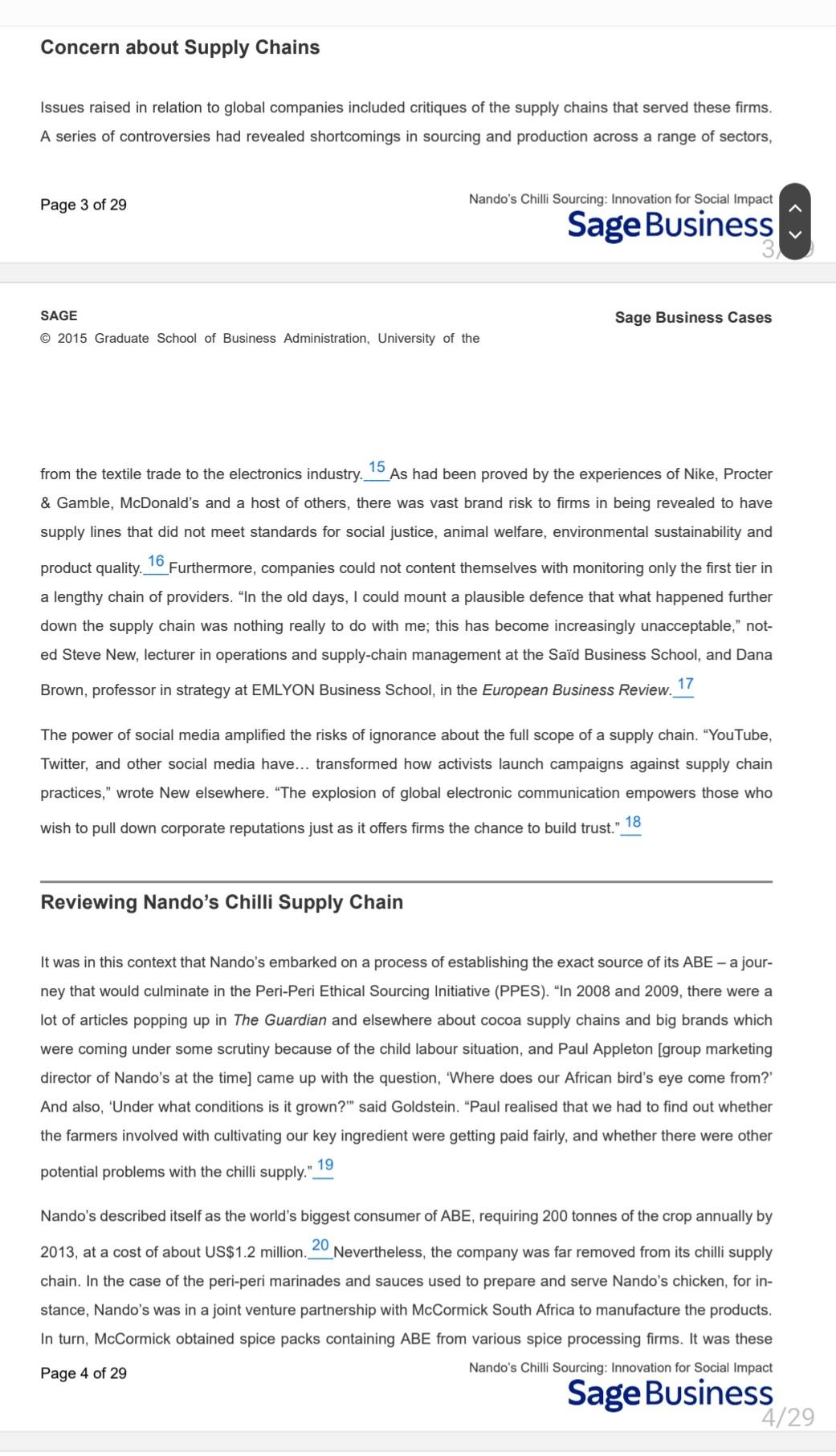
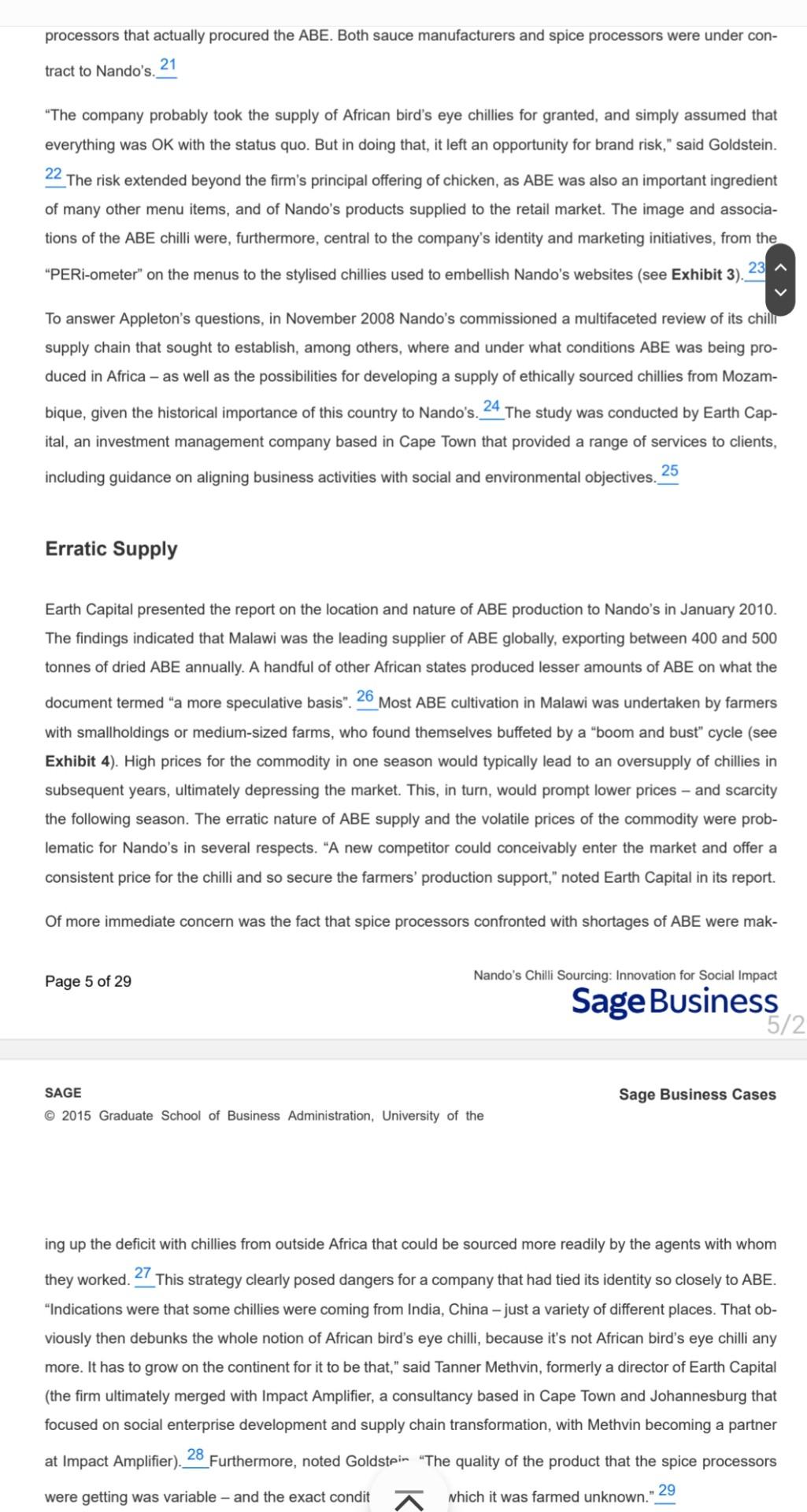
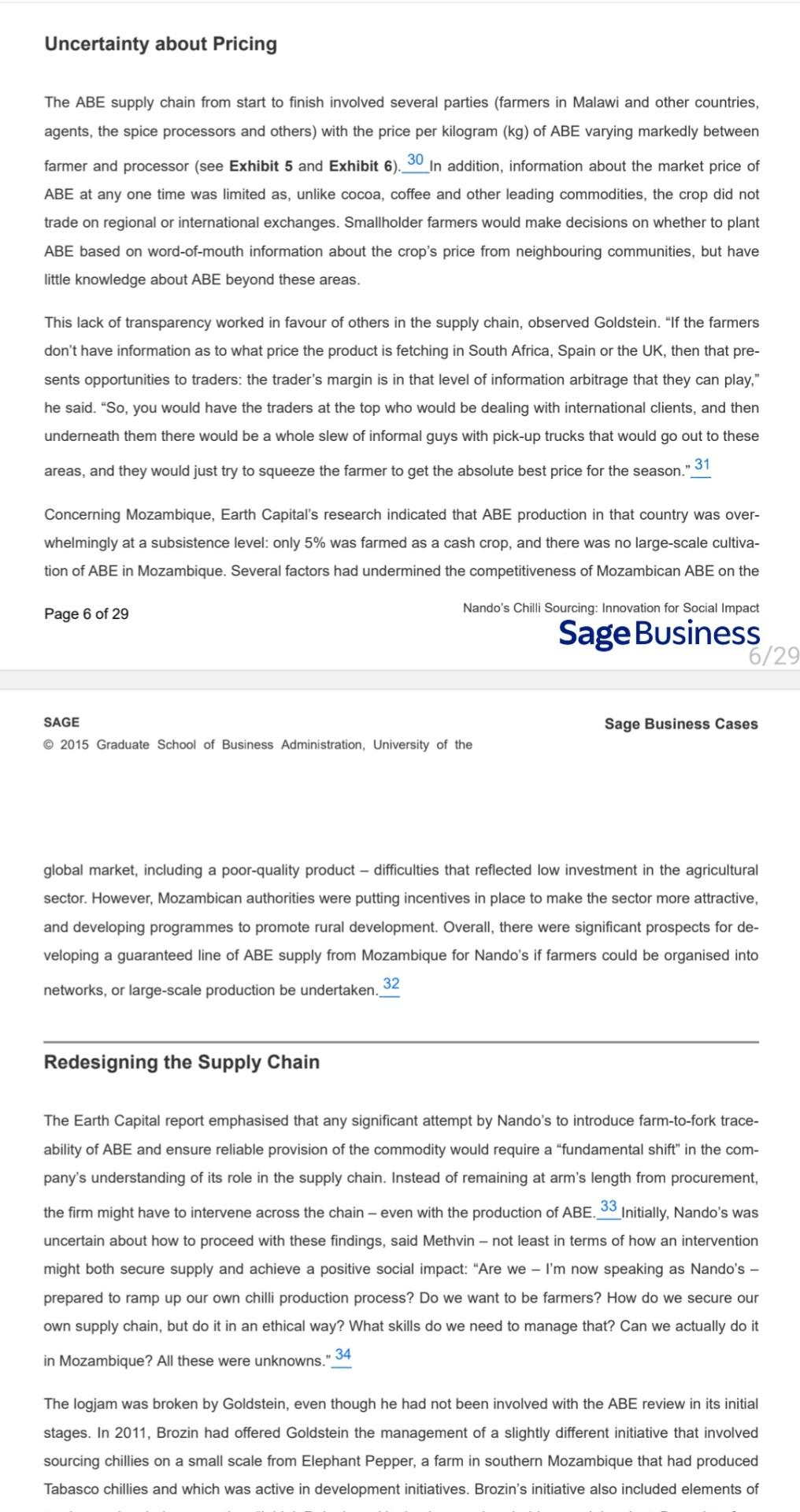
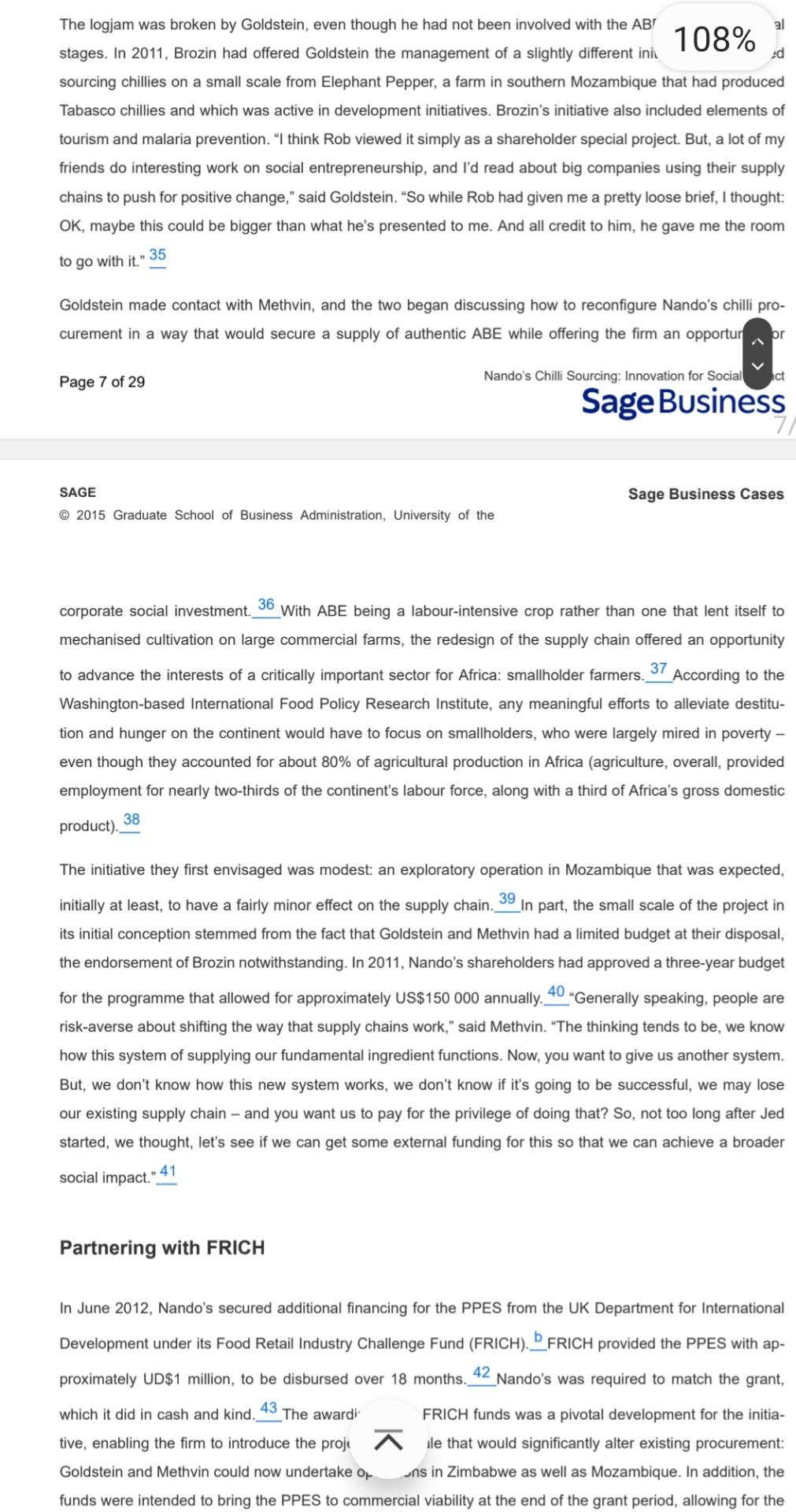
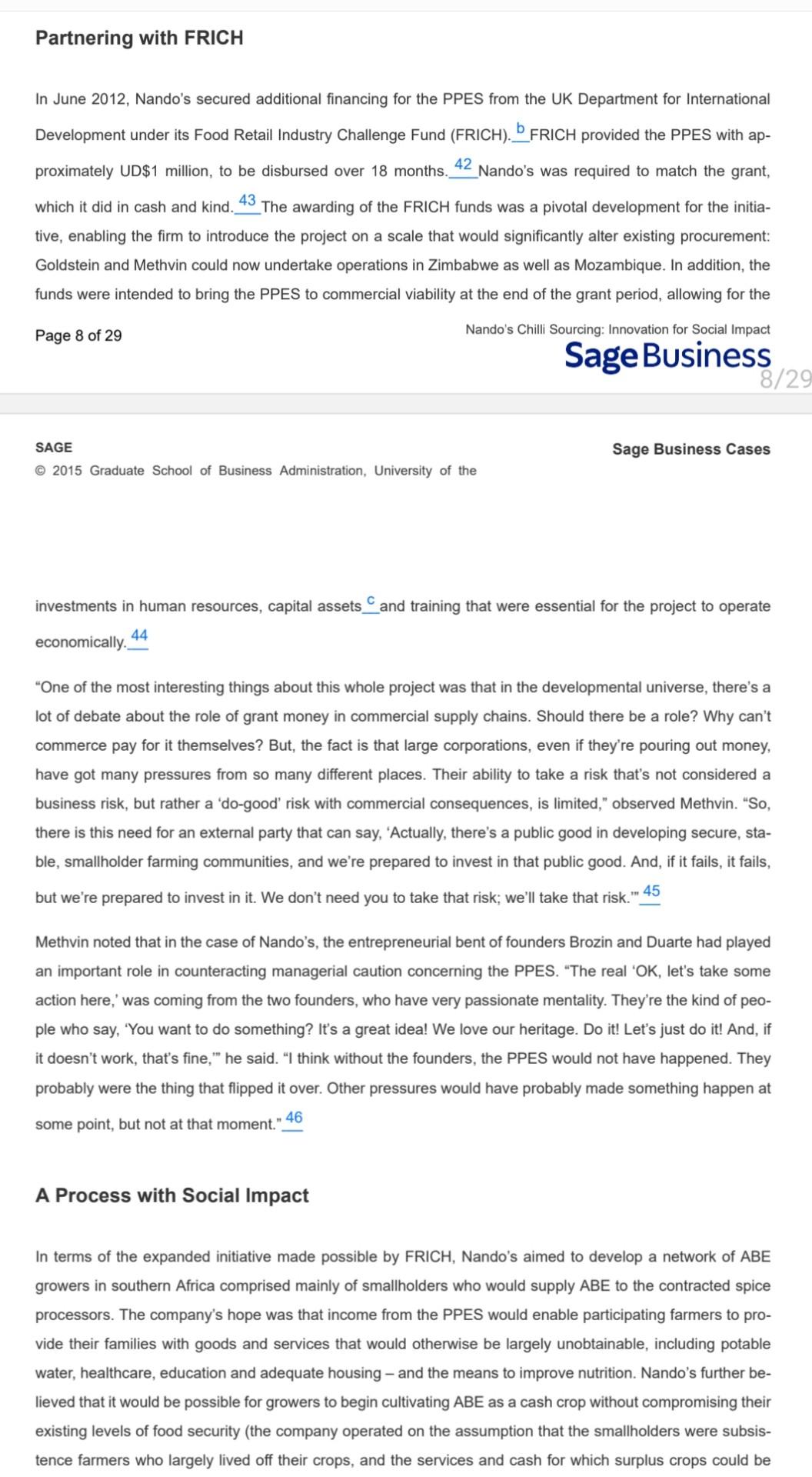

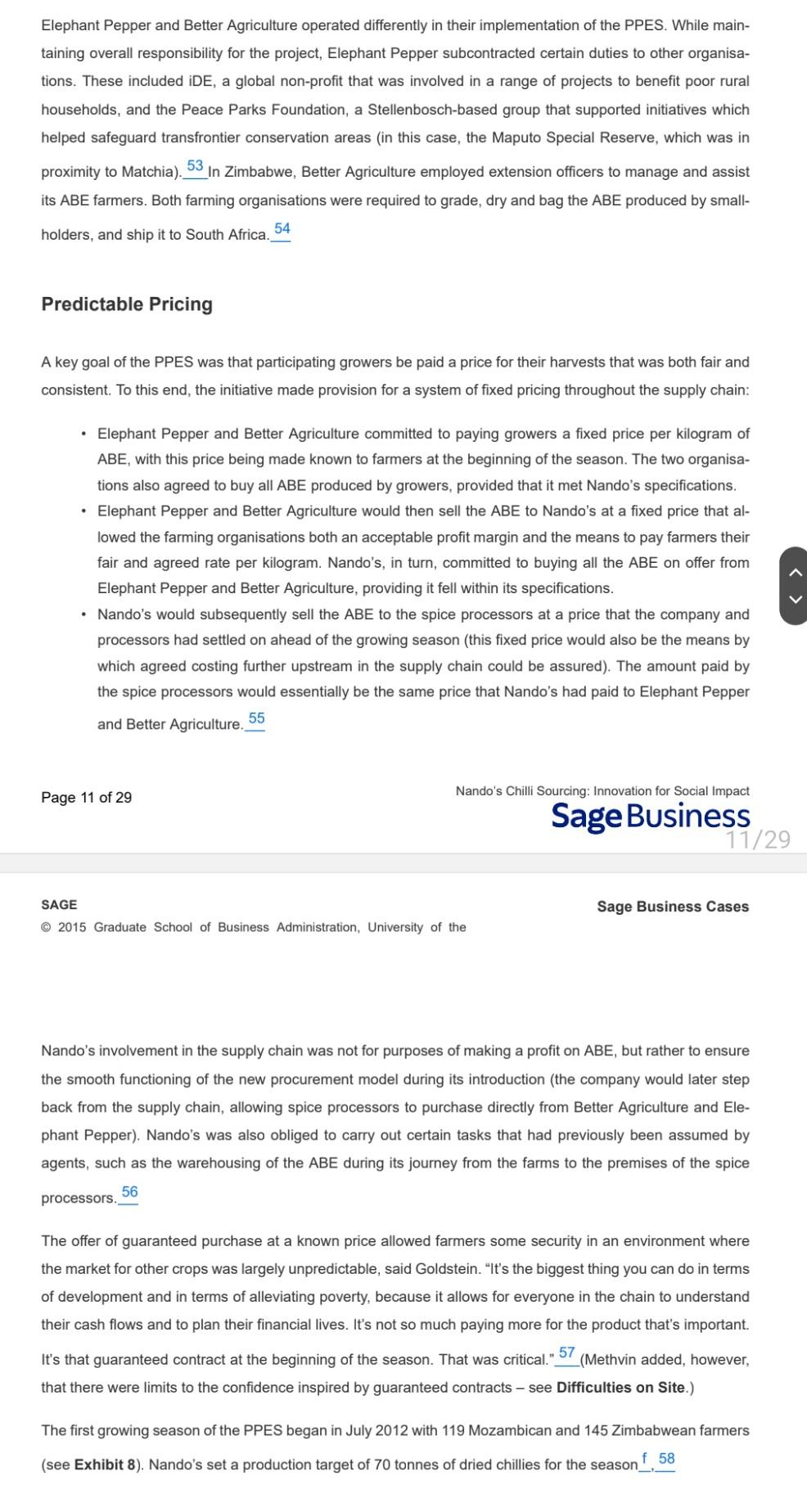
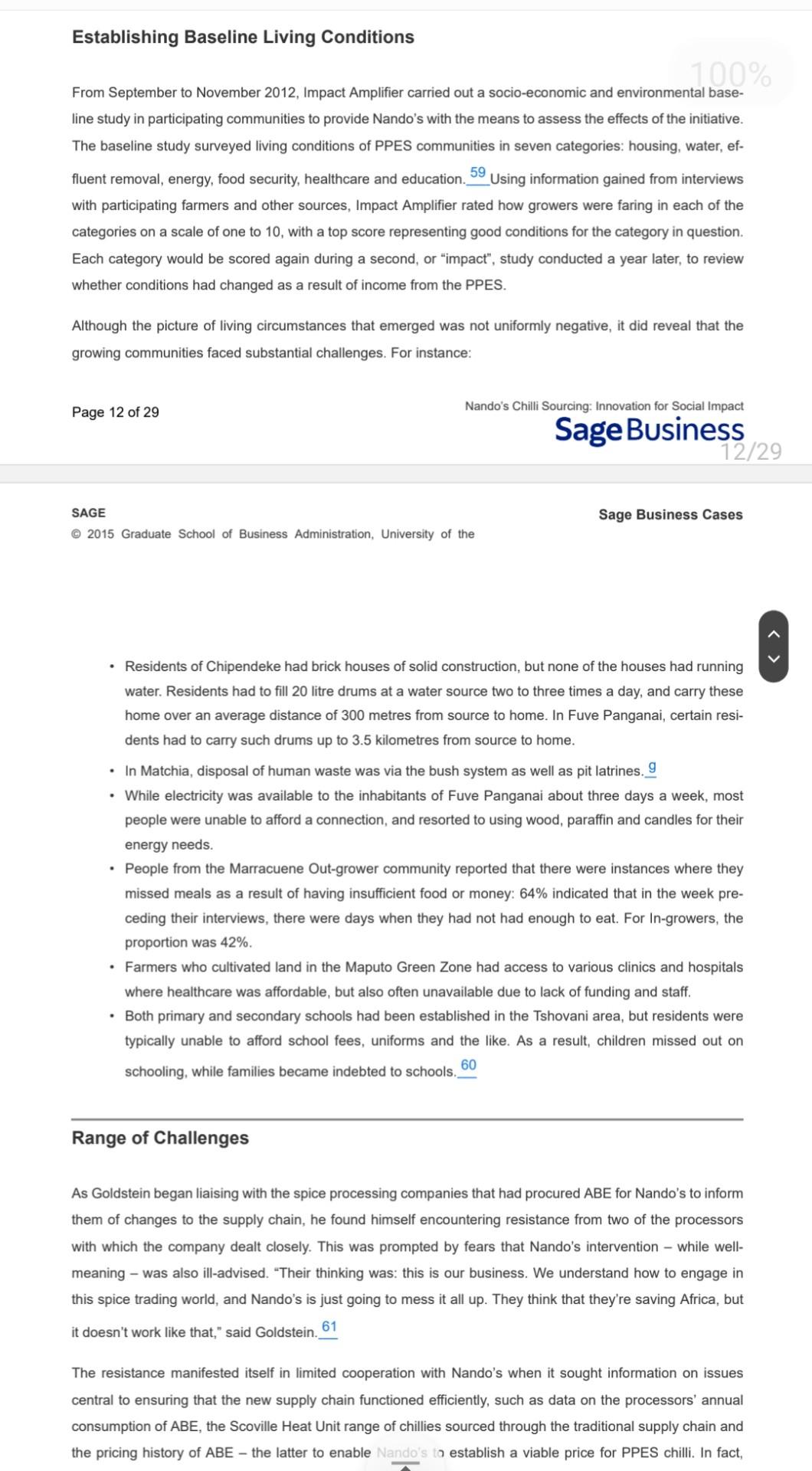
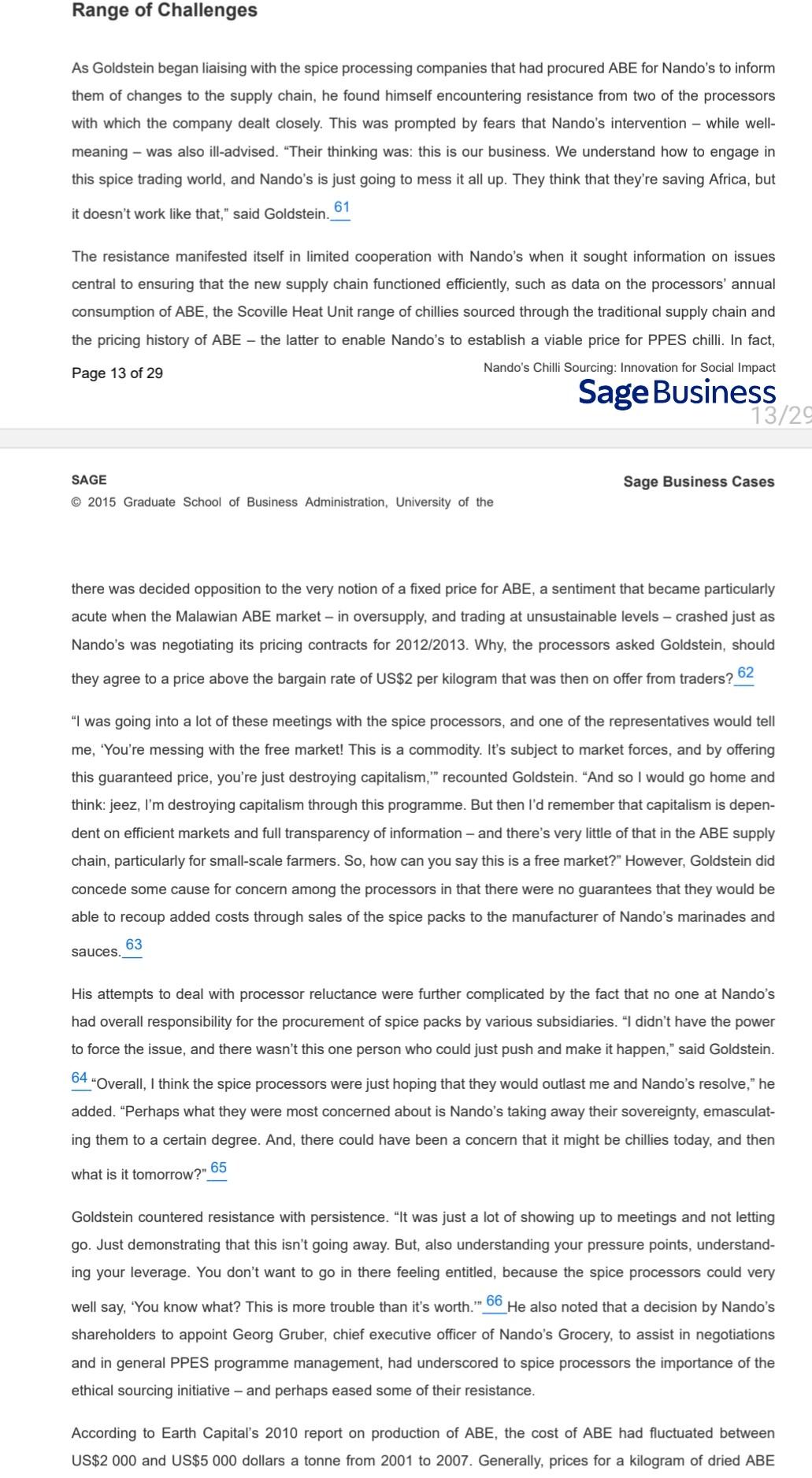
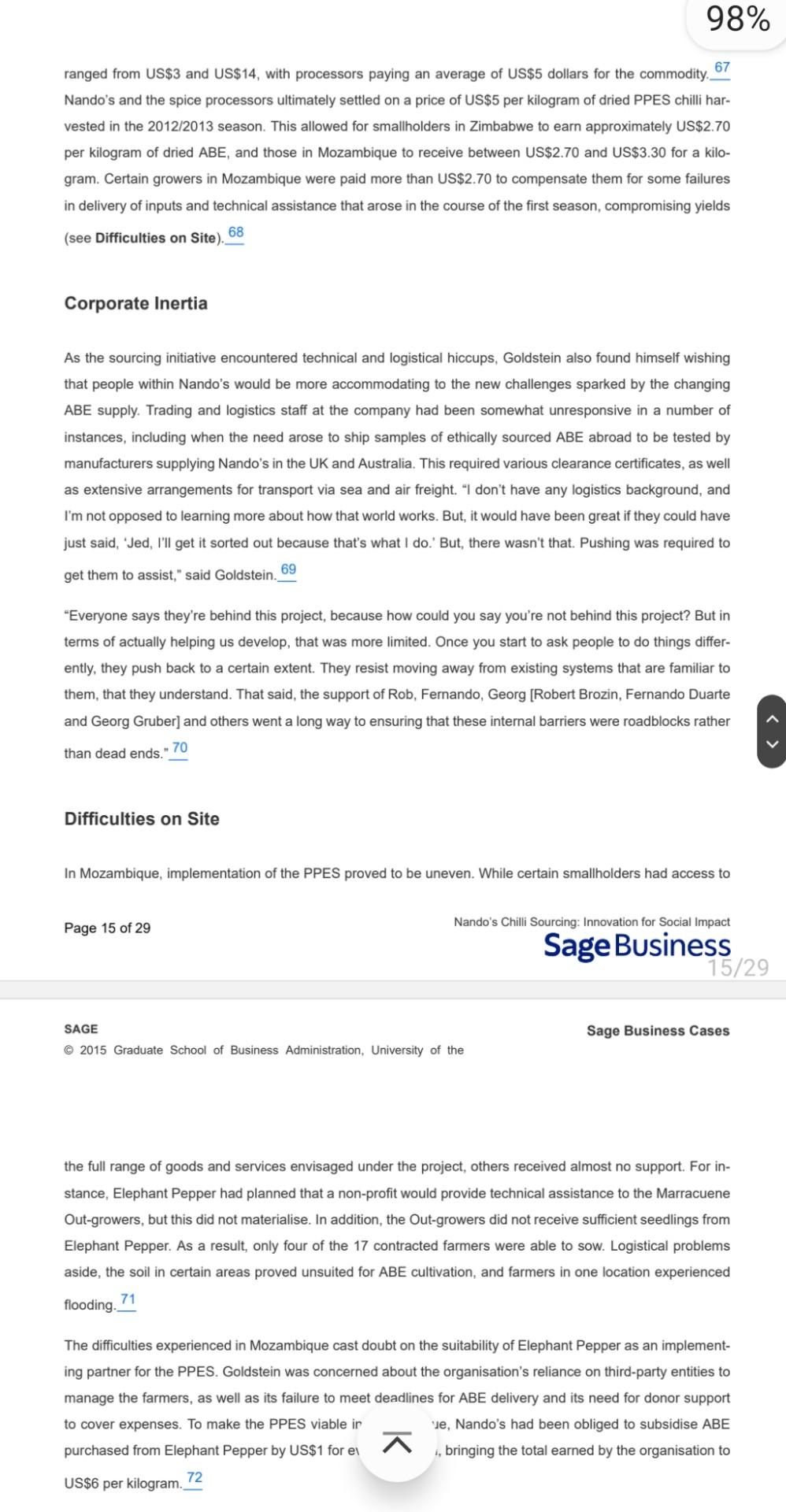
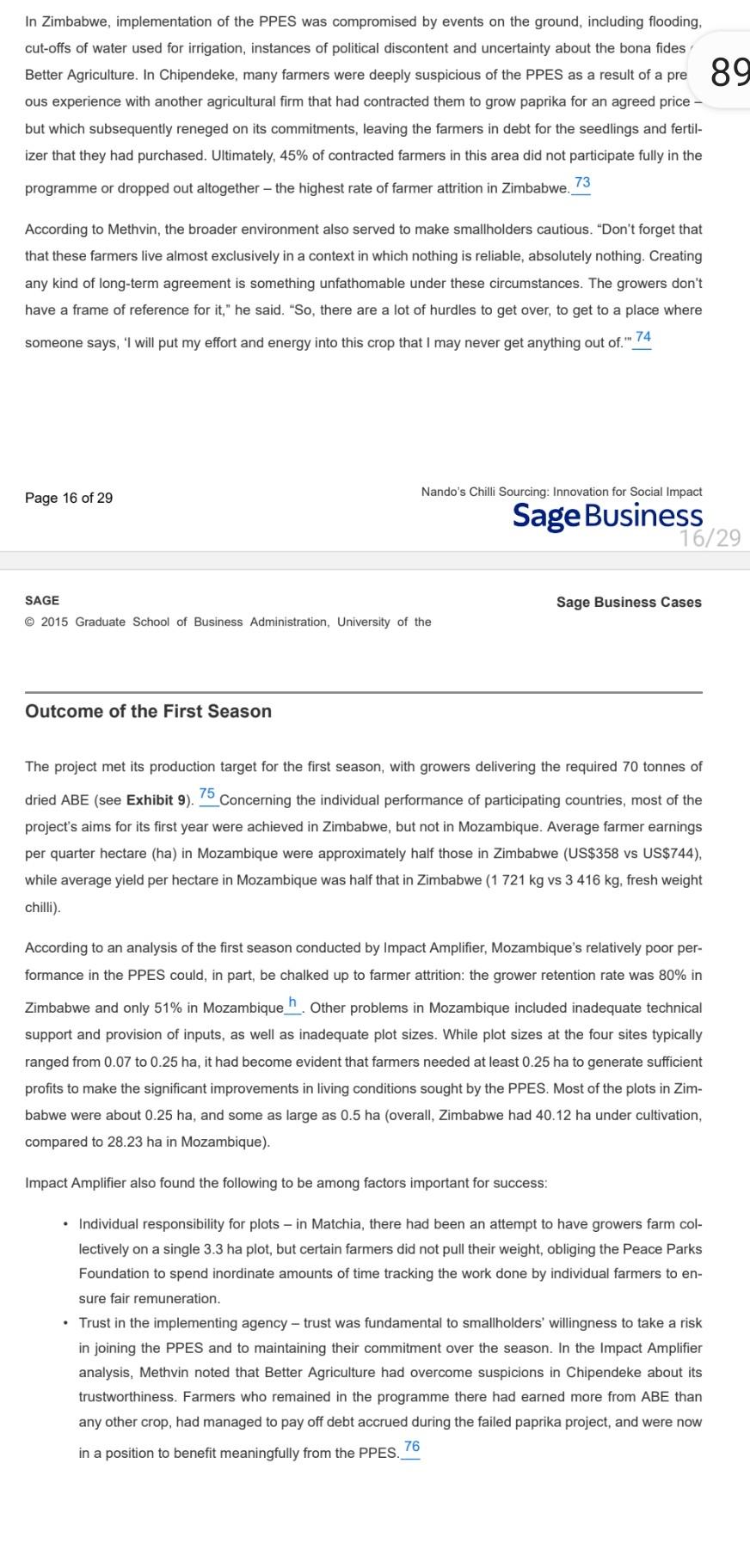
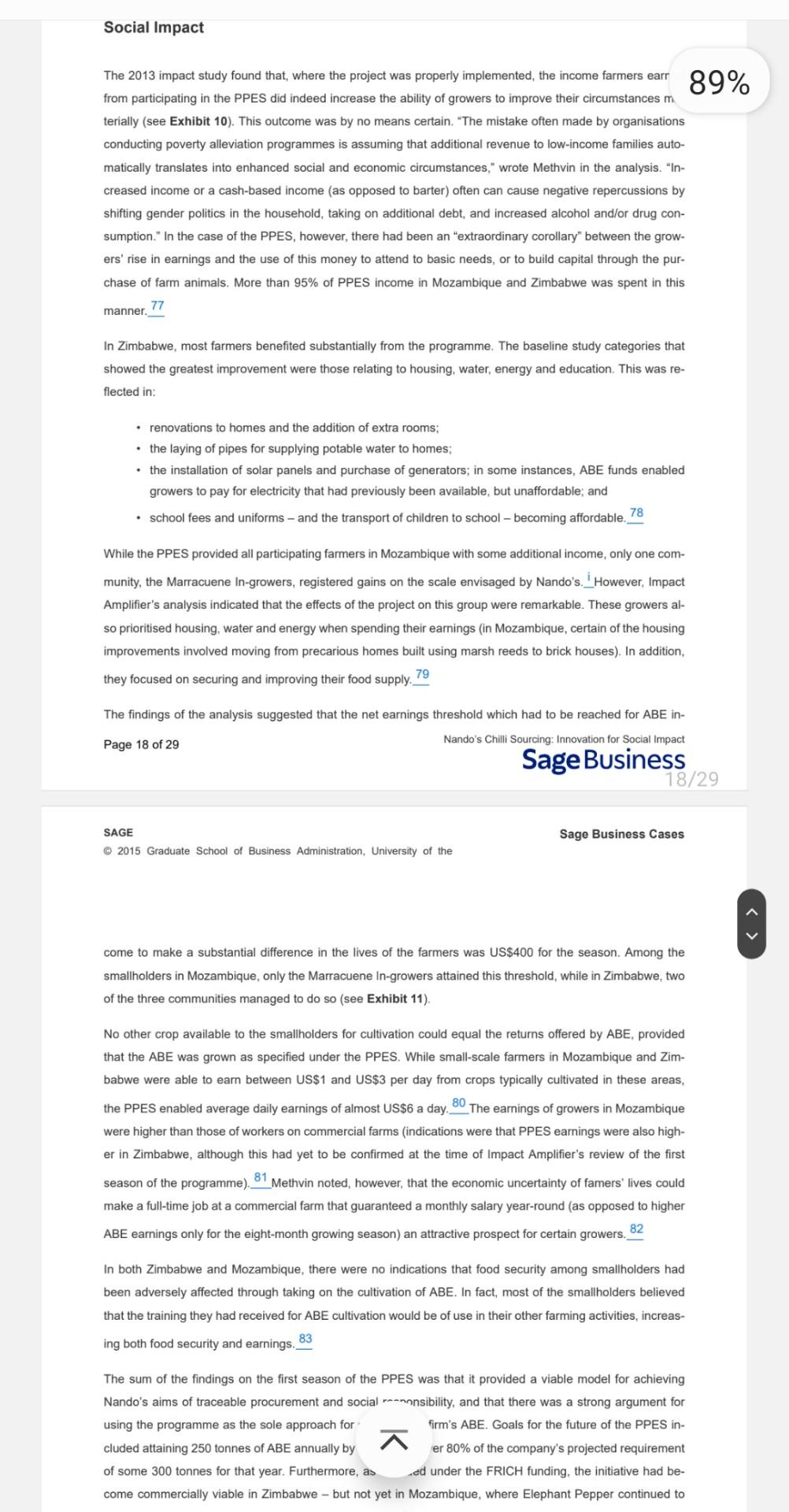
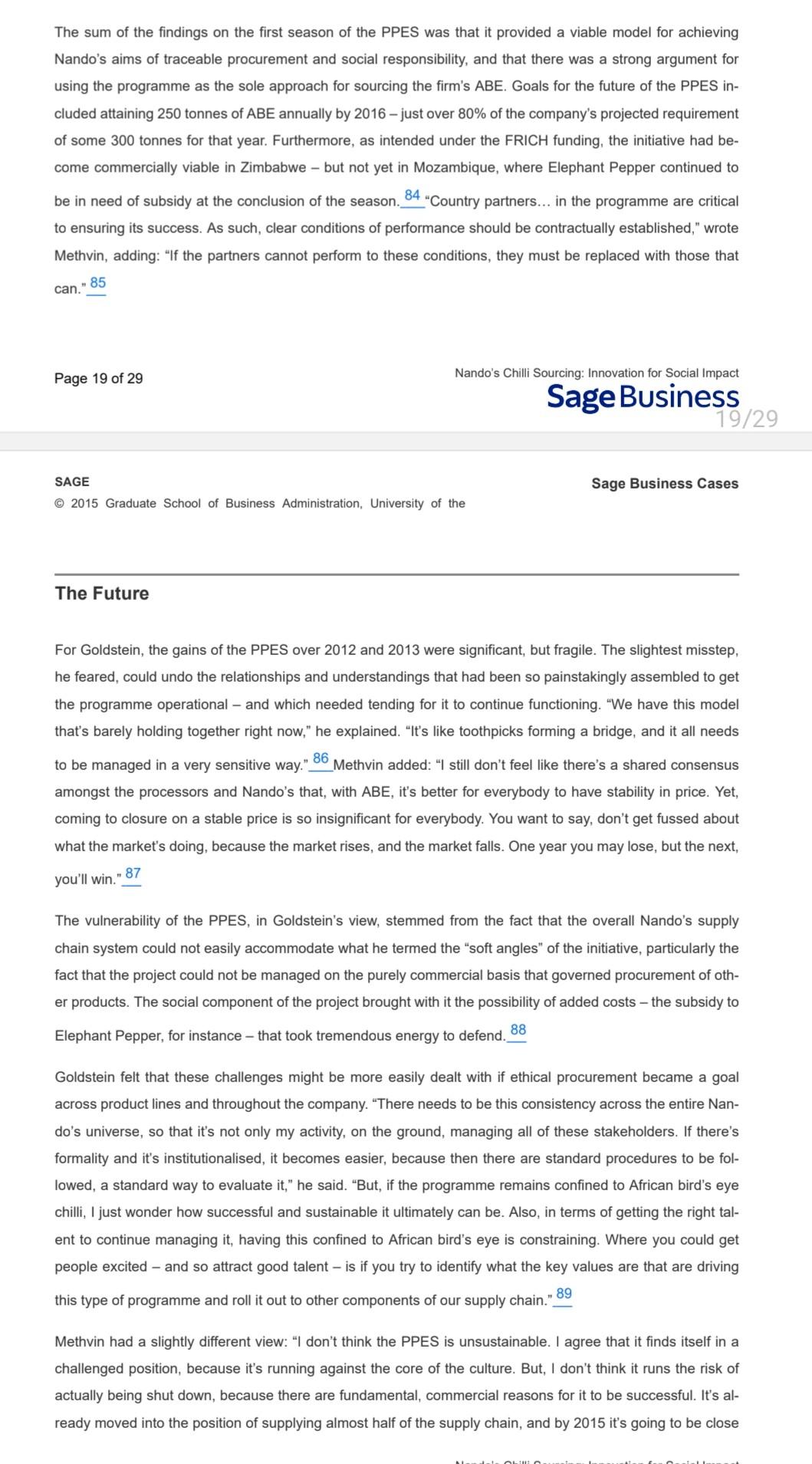
what are the issues and challanges related to performance measures in the nando's case study explain in brief.
Abstract In late 2013, Nando's, a global chicken restaurant chain, marked the successful implementation of a project for ethical sourcing of African bird's eye chillies (ABE) - the signature ingredient of the brand. The initiative had set Nando's on the road to securing its annual requirement of ABE from traceable sources, while improving the lives of participating small-scale farmers in Mozambique and Zimbabwe. However, Jed Goldstein, programme manager of the initiative, wondered whether Nando's could sustain ethical sourcing of ABE in a context where procurement of other goods and services continued unchanged. Case In late 2013, Nando's, a global chicken restaurant chain, marked the successful implementation of a proje for ethical sourcing of African bird's eye chillies (ABE) - the signature ingredient of the brand. The initiati had set Nando's on the road to securing its annual requirement of ABE from traceable sources, while proving the lives of participating small-scale farmers in Mozambique and Zimbabwe. However, Jed Goldste programme manager of the initiative, wondered whether Nando's could sustain ethical sourcing of ABE context where procurement of other goods and services continued unchanged. Background on Nando's The origins of Nando's traced back to a 1987 visit by friends Robert Brozin and Fernando Duarte to a sm caf called Chickenland, located in Rosettenville, Johannesburg Over the preceding years, this sou ern suburb of the city had become home to immigrants from Portugal and the former Portuguese colony Mozambique. 2 The caf served a dish developed by settlers in Mozambique: chicken marinated in a sau containing ABE chillies - the sauce was called peri-peri sauce - and then grilled (see Exhibit 1). and Duarte were so impressed by Chickenland's version of this dish that they subsequently bought the out for about R80 000, renaming it "Nando's" after Duarte. 4 Local and international expansion followed, with the business establishing its first overseas outlet in Portu in 1989. 5 By 2013, Nando's had about 1000 branches in South Africa and about 700 abroad in countri spanning Africa, Europe, Australasia, the Middle East and North America. Globally, Nando's employed sor Page 2 of 29 Nando's Chilli Sourcing: Innovation for Social Imp Sage Busines 23000 staff in 2013. South Africa, the United Kingdom (UK) and Australia were the leading mark. do's, which was headquartered in Lorentzville, southern Johannesburg. 6 The company formed part of the "fast casual" segment of the food chain sector: more upmarket than a simple takeaway, but less exclusive than conventional restaurants. Fast casual chains offered food that was somewhat healthier than the processed fare traditionally provided by take-outs, and they also tended to be eclectic in appearance (see Exhibit 2). 7 In South Africa and elsewhere, the firm continued to generate headlines with its use of adverts that satirised political and social trends, or capitalised on controversies. 8 Sunday Times journalist Loni Prinsloo noted: "A Nando's advert can go viral within minutes, but often lands it in hot water." 9 Social media played an important role in the company's marketing strategy. Nando's had established a presence on numerous social media sites, including YouTube, Twitter and Facebook, where promotional material in the firm's characteristically irreverent tone was posted on country-specific (sometimes even branch-specific) pages. 4 survey of social media pages designed for the UK by food and beverage brands, conducted by the London-based online marketing consultancy eDigitalResearch, later found Nando's to have more followers on Facebook and Twitter than any other firm a 11 "Nando's doesn't advertise in Britain because it doesn't need to. Its customers are, in industry jargon, its best "brand advocates'," observed journalist Mick Brown in The Telegraph. "The Twittersphere is filled with people extolling Nando's, photographing themselves eating at Nando's... and just occasionally rubbishing Nando's..." 12 Nando's had long sought to differentiate itself from other well-known chains, insisting that it was not a provider of fast food in the mould or on the scale of chains such as Kentucky Fried Chicken or McDonald's. towever, as noted in an article by The Economist, the growth of the company was inexorably placing Nando's in a position where it attracted the same degree of scrutiny as that directed at leading global brands. 14 Concern about Supply Chains Issues raised in relation to global companies included critiques of the supply chains that served these firms. A series of controversies had revealed shortcomings in sourcing and production across a range of sectors, Page 3 of 29 Nando's Chilli Sourcing: Innovation for Social Impact SageBusiness SAGE Sage Business Cases (C 2015 Graduate School of Business Administration, University of the from the textile trade to the electronics industry. 15 As had been proved by the experiences of Nike, Procter \& Gamble, McDonald's and a host of others, there was vast brand risk to firms in being revealed to have supply lines that did not meet standards for social justice, animal welfare, environmental sustainability and product quality. 16 Furthermore, companies could not content themselves with monitoring only the first tier in a lengthy chain of providers. "In the old days, I could mount a plausible defence that what happened further down the supply chain was nothing really to do with me; this has become increasingly unacceptable," noted Steve New, lecturer in operations and supply-chain management at the Sad Business School, and Dana Brown, professor in strategy at EMLYON Businer , in the European Business Review. Concern about Supply Chains Issues raised in relation to global companies included critiques of the supply chains that served these firms. A series of controversies had revealed shortcomings in sourcing and production across a range of sectors, Page 3 of 29 Nando's Chilli Sourcing: Innovation for Social Impact SageBusiness v^ SAGE Sage Business Cases (2) 2015 Graduate School of Business Administration, University of the from the textile trade to the electronics industry. As had been proved by the experiences of Nike, Procter \& Gamble, McDonald's and a host of others, there was vast brand risk to firms in being revealed to have supply lines that did not meet standards for social justice, animal welfare, environmental sustainability and product quality. Furthermore, companies could not content themselves with monitoring only the first tier in a lengthy chain of providers. "In the old days, I could mount a plausible defence that what happened further down the supply chain was nothing really to do with me; this has become increasingly unacceptable," noted Steve New, lecturer in operations and supply-chain management at the Sad Business School, and Dana Brown, professor in strategy at EMLYON Business School, in the European Business Review. 17 The power of social media amplified the risks of ignorance about the full scope of a supply chain. "YouTube, Twitter, and other social media have... transformed how activists launch campaigns against supply chain practices," wrote New elsewhere. "The explosion of global electronic communication empowers those who wish to pull down corporate reputations just as it offers firms the chance to build trust.' Reviewing Nando's Chilli Supply Chain It was in this context that Nando's embarked on a process of establishing the exact source of its ABE - a journey that would culminate in the Peri-Peri Ethical Sourcing Initiative (PPES). "In 2008 and 2009, there were a lot of articles popping up in The Guardian and elsewhere about cocoa supply chains and big brands which were coming under some scrutiny because of the child labour situation, and Paul Appleton [group marketing director of Nando's at the time] came up with the question, 'Where does our African bird's eye come from?' And also, 'Under what conditions is it grown?"' said Goldstein. "Paul realised that we had to find out whether the farmers involved with cultivating our key ingredient were getting paid fairly, and whether there were other potential problems with the chilli supply.' Nando's described itself as the world's biggest consumer of ABE, requiring 200 tonnes of the crop annually by 2013, at a cost of about US $1.2 million. 20 Nevertheless, the company was far removed from its chilli supply chain. In the case of the peri-peri marinades and sauces used to prepare and serve Nando's chicken, for instance, Nando's was in a joint venture partnership with McCormick South Africa to manufacture the products. In turn, McCormick obtained spice packs containing ABE from various spice processing firms. It was these Page 4 of 29 Nando's Chilli Sourcing: Innovation for Social Impact Sage Business processors that actually procured the ABE. Both sauce manufacturers and spice processors were under contract to Nando's. "The company probably took the supply of African bird's eye chillies for granted, and simply assumed that everything was OK with the status quo. But in doing that, it left an opportunity for brand risk," said Goldstein. 22 The risk extended beyond the firm's principal offering of chicken, as ABE was also an important ingredient of many other menu items, and of Nando's products supplied to the retail market. The image and associations of the ABE chilli were, furthermore, central to the company's identity and marketing initiatives, from the "PERi-ometer" on the menus to the stylised chillies used to embellish Nando's websites (see Exhibit 3). 23 To answer Appleton's questions, in November 2008 Nando's commissioned a multifaceted review of its chill supply chain that sought to establish, among others, where and under what conditions ABE was being produced in Africa - as well as the possibilities for developing a supply of ethically sourced chillies from Mozambique, given the historical importance of this country to Nando's. 24 The study was conducted by Earth Capital, an investment management company based in Cape Town that provided a range of services to clients, including guidance on aligning business activities with social and environmental objectives. 25 Erratic Supply Earth Capital presented the report on the location and nature of ABE production to Nando's in January 2010. The findings indicated that Malawi was the leading supplier of ABE globally, exporting between 400 and 500 tonnes of dried ABE annually. A handful of other African states produced lesser amounts of ABE on what the document termed "a more speculative basis". 26 Most ABE cultivation in Malawi was undertaken by farmers with smallholdings or medium-sized farms, who found themselves buffeted by a "boom and bust" cycle (see Exhibit 4). High prices for the commodity in one season would typically lead to an oversupply of chillies in subsequent years, ultimately depressing the market. This, in turn, would prompt lower prices - and scarcity the following season. The erratic nature of ABE supply and the volatile prices of the commodity were problematic for Nando's in several respects. "A new competitor could conceivably enter the market and offer a consistent price for the chilli and so secure the farmers' production support," noted Earth Capital in its report. Of more immediate concern was the fact that spice processors confronted with shortages of ABE were mak- Page 5 of 29 Nando's Chilli Sourcing: Innovation for Social Impact Sage Business SAGE Sage Business Cases ( 2015 Graduate School of Business Administration, University of the ing up the deficit with chillies from outside Africa that could be sourced more readily by the agents with whom they worked. 27 This strategy clearly posed dangers for a company that had tied its identity so closely to ABE. "Indications were that some chillies were coming from India, China - just a variety of different places. That obviously then debunks the whole notion of African bird's eye chilli, because it's not African bird's eye chilli any more. It has to grow on the continent for it to be that," said Tanner Methvin, formerly a director of Earth Capital (the firm ultimately merged with Impact Amplifier, a consultancy based in Cape Town and Johannesburg that focused on social enterprise development and supply chain transformation, with Methvin becoming a partner at Impact Amplifier) Furthermore, noted Goldstein "The quality of the product that the spice processors were getting was variable - and the exact condit which it was farmed unknown." 29 Uncertainty about Pricing The ABE supply chain from start to finish involved several parties (farmers in Malawi and other countries, agents, the spice processors and others) with the price per kilogram ( kg) of ABE varying markedly between farmer and processor (see Exhibit 5 and Exhibit 6). 30 In addition, information about the market price of ABE at any one time was limited as, unlike cocoa, coffee and other leading commodities, the crop did not trade on regional or international exchanges. Smallholder farmers would make decisions on whether to plant ABE based on word-of-mouth information about the crop's price from neighbouring communities, but have little knowledge about ABE beyond these areas. This lack of transparency worked in favour of others in the supply chain, observed Goldstein. "If the farmers don't have information as to what price the product is fetching in South Africa, Spain or the UK, then that presents opportunities to traders: the trader's margin is in that level of information arbitrage that they can play," he said. "So, you would have the traders at the top who would be dealing with international clients, and then underneath them there would be a whole slew of informal guys with pick-up trucks that would go out to these areas, and they would just try to squeeze the farmer to get the absolute best price for the season. Concerning Mozambique, Earth Capital's research indicated that ABE production in that country was overwhelmingly at a subsistence level: only 5% was farmed as a cash crop, and there was no large-scale cultivation of ABE in Mozambique. Several factors had undermined the competitiveness of Mozambican ABE on the Page 6 of 29 Nando's Chilli Sourcing: Innovation for Social Impact Sage Business SAGE Sage Business Cases (c) 2015 Graduate School of Business Administration, University of the global market, including a poor-quality product - difficulties that reflected low investment in the agricultural sector. However, Mozambican authorities were putting incentives in place to make the sector more attractive, and developing programmes to promote rural development. Overall, there were significant prospects for developing a guaranteed line of ABE supply from Mozambique for Nando's if farmers could be organised into networks, or large-scale production be undertaken. 32 Redesigning the Supply Chain The Earth Capital report emphasised that any significant attempt by Nando's to introduce farm-to-fork traceability of ABE and ensure reliable provision of the commodity would require a "fundamental shift" in the company's understanding of its role in the supply chain. Instead of remaining at arm's length from procurement, the firm might have to intervene across the chain - even with the production of ABE. 33 Initially, Nando's was uncertain about how to proceed with these findings, said Methvin - not least in terms of how an intervention might both secure supply and achieve a positive social impact: "Are we - I'm now speaking as Nando's prepared to ramp up our own chilli production process? Do we want to be farmers? How do we secure our own supply chain, but do it in an ethical way? What skills do we need to manage that? Can we actually do it in Mozambique? All these were unknowns." 34 The logjam was broken by Goldstein, even though he had not been involved with the ABE review in its initial stages. In 2011, Brozin had offered Goldstein the management of a slightly different initiative that involved sourcing chillies on a small scale from Elephant Pepper, a farm in southern Mozambique that had produced Tabasco chillies and which was active in development initiatives. Brozin's initiative also included elements of The logjam was broken by Goldstein, even though he had not been involved with the ABI stages. In 2011, Brozin had offered Goldstein the management of a slightly different ini 108% ad sourcing chillies on a small scale from Elephant Pepper, a farm in southern Mozambique that had produced Tabasco chillies and which was active in development initiatives. Brozin's initiative also included elements of tourism and malaria prevention. "I think Rob viewed it simply as a shareholder special project. But, a lot of my friends do interesting work on social entrepreneurship, and l'd read about big companies using their supply chains to push for positive change," said Goldstein. "So while Rob had given me a pretty loose brief, I thought: OK, maybe this could be bigger than what he's presented to me. And all credit to him, he gave me the room to go with it." Goldstein made contact with Methvin, and the two began discussing how to reconfigure Nando's chilli procurement in a way that would secure a supply of authentic ABE while offering the firm an opportu Page 7 of 29 Nando's Chilli Sourcing: Innovation for Socia SageBusiness SAGE Sage Business Cases (c) 2015 Graduate School of Business Administration, University of the corporate social investment. 36 With ABE being a labour-intensive crop rather than one that lent itself to mechanised cultivation on large commercial farms, the redesign of the supply chain offered an opportunity to advance the interests of a critically important sector for Africa: smallholder farmers. 37 According to the Washington-based International Food Policy Research Institute, any meaningful efforts to alleviate destitution and hunger on the continent would have to focus on smallholders, who were largely mired in poverty even though they accounted for about 80% of agricultural production in Africa (agriculture, overall, provided employment for nearly two-thirds of the continent's labour force, along with a third of Africa's gross domestic product). The initiative they first envisaged was modest: an exploratory operation in Mozambique that was expected, initially at least, to have a fairly minor effect on the supply chain. In part, the small scale of the project in its initial conception stemmed from the fact that Goldstein and Methvin had a limited budget at their disposal, the endorsement of Brozin notwithstanding. In 2011, Nando's shareholders had approved a three-year budget for the programme that allowed for approximately US $150000 annually. 40 "Generally speaking, people are risk-averse about shifting the way that supply chains work," said Methvin. "The thinking tends to be, we know how this system of supplying our fundamental ingredient functions. Now, you want to give us another system. But, we don't know how this new system works, we don't know if it's going to be successful, we may lose our existing supply chain - and you want us to pay for the privilege of doing that? So, not too long after Jed started, we thought, let's see if we can get some external funding for this so that we can achieve a broader social impact." 41 Partnering with FRICH In June 2012, Nando's secured additional financing for the PPES from the UK Department for International Development under its Food Retail Industry Challenge Fund (FRICH). FRICH provided the PPES with approximately UD\$1 million, to be disbursed over 18 months Nando's was required to match the grant, which it did in cash and kind. The awardi FRICH funds was a pivotal development for the initiative, enabling the firm to introduce the proje ile that would significantly alter existing procurement: Goldstein and Methvin could now undertake or uns in Zimbabwe as well as Mozambique. In addition, the funds were intended to bring the PPES to commercial viability at the end of the grant period, allowing for the Partnering with FRICH In June 2012, Nando's secured additional financing for the PPES from the UK Department for International Development under its Food Retail Industry Challenge Fund (FRICH). b FRICH provided the PPES with approximately UD\$1 million, to be disbursed over 18 months. 42 Nando's was required to match the grant, which it did in cash and kind. 43 The awarding of the FRICH funds was a pivotal development for the initiative, enabling the firm to introduce the project on a scale that would significantly alter existing procurement: Goldstein and Methvin could now undertake operations in Zimbabwe as well as Mozambique. In addition, the funds were intended to bring the PPES to commercial viability at the end of the grant period, allowing for the Page 8 of 29 Nando's Chilli Sourcing: Innovation for Social Impact SageBusiness SAGE Sage Business Cases (2) 2015 Graduate School of Business Administration, University of the investments in human resources, capital assets c and training that were essential for the project to operate economically. 44 "One of the most interesting things about this whole project was that in the developmental universe, there's a lot of debate about the role of grant money in commercial supply chains. Should there be a role? Why can't commerce pay for it themselves? But, the fact is that large corporations, even if they're pouring out money, have got many pressures from so many different places. Their ability to take a risk that's not considered a business risk, but rather a 'do-good' risk with commercial consequences, is limited," observed Methvin. "So, there is this need for an external party that can say, 'Actually, there's a public good in developing secure, stable, smallholder farming communities, and we're prepared to invest in that public good. And, if it fails, it fails, but we're prepared to invest in it. We don't need you to take that risk; we'll take that risk."' 45 Methvin noted that in the case of Nando's, the entrepreneurial bent of founders Brozin and Duarte had played an important role in counteracting managerial caution concerning the PPES. "The real 'OK, let's take some action here,' was coming from the two founders, who have very passionate mentality. They're the kind of people who say, 'You want to do something? It's a great idea! We love our heritage. Do it! Let's just do it! And, if it doesn't work, that's fine,"' he said. "I think without the founders, the PPES would not have happened. They probably were the thing that flipped it over. Other pressures would have probably made something happen at some point, but not at that moment." A Process with Social Impact In terms of the expanded initiative made possible by FRICH, Nando's aimed to develop a network of ABE growers in southern Africa comprised mainly of smallholders who would supply ABE to the contracted spice processors. The company's hope was that income from the PPES would enable participating farmers to provide their families with goods and services that would otherwise be largely unobtainable, including potable water, healthcare, education and adequate housing - and the means to improve nutrition. Nando's further believed that it would be possible for growers to begin cultivating ABE as a cash crop without compromising their existing levels of food security (the company operated on the assumption that the smallholders were subsistence farmers who largely lived off their crops, and the services and cash for which surplus crops could be traded). In addition, Nando's thought that buying chillies from small-scale farmers would do more to address basic needs than sourcing the crop from larger farms, which drew wage labour from rural communities. 47 The significance of smallholders in Africa notwithstanding, there were many proponents of the view that the best path forward for agriculture on the continent lay in centralising production on large, industrialised farms. 48 The PPES was initially implemented in Mozambique and Zimbabwe, where some 70% and 62% of the population, respectively, lived in rural areas and depended on agriculture for a living. In addition, in Zimbabwe, 72.3% of people were estimated to be living at or below national poverty lines d, while 59.6% of people in Mozambique lived below the international poverty line of US $1.25 a day. 49 The historical associations of Mozambique aside, the two countries were chosen in part because both had small-scale farmers with access to irrigation. Nando's introduced the initiative at three sites in south-eastern Zimbabwe - the villages of Chipendeke and Fuve Panganai, and the communal area of Tshovani - and at four locations in Mozambique, all in the south of the country. Two of the Mozambiquan sites were in the Marracuene area, one in the Matchia area, and another in one of the Maputo Green Zones e (see Exhibit 7). One of the Marracuene sites consisted of land on the Elephant Pepper farm that was allotted for cultivation to employees of the farm and smallholders not on staff - a group collectively referred to as the Marracuene "In-growers". The second group of farmers from this area was named the Marracuene "Out-growers". In addition, the PPES in Mozambique included five participants termed "emerging farmers" who were active in several locations, but much better off than the smallholders with regard to the amount of land that they owned and their financial circumstances. None of the participating farmers in Zimbabwe or Mozambique had grown ABE before as a cash crop. 50 As Nando's was not in the business of farming, it appointed Elephant Pepper to implement the PPES in Mozambique, and Better Agriculture - an organisation that provided management consultancy services to small farmers - in Zimbabwe. 51 Elephant Pepper and Better Agriculture had to recruit and contract smallholders for the programme, and ensure that they were provided with the support services and goods essential for maximum yields. These included seedlings (all of an ABE variety developed for Nando's, to ensure that PPES chilli met company requirements), fertilizers and herbicides (termed "inputs"), as well as technical as- Page 10 of 29 Nando's Chilli Sourcing: Innovation for Social Impact Sage Business SAGE Sage Business Cases (C) 2015 Graduate School of Business Administration, University of the sistance in the use of these agricultural products and with the various stages of the ABE growing process. Farmers could purchase inputs on credit, with payment to be deducted from the amount received in the sale of ABE to Elephant Pepper or Better Agriculture. 52 Elephant Pepper and Better Agriculture operated differently in their implementation of the PPES. While maintaining overall responsibility for the project, Elephant Pepper subcontracted certain duties to other organisations. These included iDE, a global non-profit that was involved in a range of projects to benefit poor rural households, and the Peace Parks Foundation, a Stellenbosch-based group that supported initiatives which helped safeguard transfrontier conservation areas (in this case, the Maputo Special Reserve, which was in proximity to Matchia). 53 In Zimbabwe, Better Agriculture employed extension officers to manage and assist its ABE farmers. Both farming organisations were required to grade, dry and bag the ABE produced by smallholders, and ship it to South Africa. 54 Elephant Pepper and Better Agriculture operated differently in their implementation of the PPES. While maintaining overall responsibility for the project, Elephant Pepper subcontracted certain duties to other organisations. These included iDE, a global non-profit that was involved in a range of projects to benefit poor rural households, and the Peace Parks Foundation, a Stellenbosch-based group that supported initiatives which helped safeguard transfrontier conservation areas (in this case, the Maputo Special Reserve, which was in proximity to Matchia). 53 In Zimbabwe, Better Agriculture employed extension officers to manage and assist its ABE farmers. Both farming organisations were required to grade, dry and bag the ABE produced by smallholders, and ship it to South Africa. 54 Predictable Pricing A key goal of the PPES was that participating growers be paid a price for their harvests that was both fair and consistent. To this end, the initiative made provision for a system of fixed pricing throughout the supply chain: - Elephant Pepper and Better Agriculture committed to paying growers a fixed price per kilogram of ABE, with this price being made known to farmers at the beginning of the season. The two organisations also agreed to buy all ABE produced by growers, provided that it met Nando's specifications. - Elephant Pepper and Better Agriculture would then sell the ABE to Nando's at a fixed price that allowed the farming organisations both an acceptable profit margin and the means to pay farmers their fair and agreed rate per kilogram. Nando's, in turn, committed to buying all the ABE on offer from Elephant Pepper and Better Agriculture, providing it fell within its specifications. - Nando's would subsequently sell the ABE to the spice processors at a price that the company and processors had settled on ahead of the growing season (this fixed price would also be the means by which agreed costing further upstream in the supply chain could be assured). The amount paid by the spice processors would essentially be the same price that Nando's had paid to Elephant Pepper and Better Agriculture. 55 Page 11 of 29 Nando's Chilli Sourcing: Innovation for Social Impact SageBusiness SAGE Sage Business Cases (C) 2015 Graduate School of Business Administration, University of the Nando's involvement in the supply chain was not for purposes of making a profit on ABE, but rather to ensure the smooth functioning of the new procurement model during its introduction (the company would later step back from the supply chain, allowing spice processors to purchase directly from Better Agriculture and Elephant Pepper). Nando's was also obliged to carry out certain tasks that had previously been assumed by agents, such as the warehousing of the ABE during its journey from the farms to the premises of the spice processors. 56 The offer of guaranteed purchase at a known price allowed farmers some security in an environment where the market for other crops was largely unpredictable, said Goldstein. "It's the biggest thing you can do in terms of development and in terms of alleviating poverty, because it allows for everyone in the chain to understand their cash flows and to plan their financial lives. It's not so much paying more for the product that's important. It's that guaranteed contract at the beginning of the season. That was critical." (Methvin added, however, that there were limits to the confidence inspired by guaranteed contracts - see Difficulties on Site.) The first growing season of the PPES began in July 2012 with 119 Mozambican and 145 Zimbabwean farmers (see Exhibit 8). Nando's set a production target of 70 tonnes of dried chillies for the seasor Establishing Baseline Living Conditions From September to November 2012, Impact Amplifier carried out a socio-economic and environmental baseline study in participating communities to provide Nando's with the means to assess the effects of the initiative. The baseline study surveyed living conditions of PPES communities in seven categories: housing, water, effluent removal, energy, food security, healthcare and education. Using information gained from interviews with participating farmers and other sources, Impact Amplifier rated how growers were faring in each of the categories on a scale of one to 10 , with a top score representing good conditions for the category in question. Each category would be scored again during a second, or "impact", study conducted a year later, to review whether conditions had changed as a result of income from the PPES. Although the picture of living circumstances that emerged was not uniformly negative, it did reveal that the growing communities faced substantial challenges. For instance: Page 12 of 29 Nando's Chilli Sourcing: Innovation for Social Impact Sage Business SAGE Sage Business Cases 2015 Graduate School of Business Administration, University of the - Residents of Chipendeke had brick houses of solid construction, but none of the houses had running water. Residents had to fill 20 litre drums at a water source two to three times a day, and carry these home over an average distance of 300 metres from source to home. In Fuve Panganai, certain residents had to carry such drums up to 3.5 kilometres from source to home. - In Matchia, disposal of human waste was via the bush system as well as pit latrines. g - While electricity was available to the inhabitants of Fuve Panganai about three days a week, most people were unable to afford a connection, and resorted to using wood, paraffin and candles for their energy needs. - People from the Marracuene Out-grower community reported that there were instances where they missed meals as a result of having insufficient food or money: 64% indicated that in the week preceding their interviews, there were days when they had not had enough to eat. For In-growers, the proportion was 42%. - Farmers who cultivated land in the Maputo Green Zone had access to various clinics and hospitals where healthcare was affordable, but also often unavailable due to lack of funding and staff. - Both primary and secondary schools had been established in the Tshovani area, but residents were typically unable to afford school fees, uniforms and the like. As a result, children missed out on schooling, while families became indebted to schools. Range of Challenges As Goldstein began liaising with the spice processing companies that had procured ABE for Nando's to inform them of changes to the supply chain, he found himself encountering resistance from two of the processors with which the company dealt closely. This was prompted by fears that Nando's intervention - while wellmeaning - was also ill-advised. "Their thinking was: this is our business. We understand how to engage in this spice trading world, and Nando's is just going to mess it all up. They think that they're saving Africa, but it doesn't work like that," said Goldstein. 61 The resistance manifested itself in limited cooperation with Nando's when it sought information on issues central to ensuring that the new supply chain functioned efficiently, such as data on the processors' annual consumption of ABE, the Scoville Heat Unit range of chillies sourced through the traditional supply chain and the pricing history of ABE - the latter to enable Nando's to establish a viable price for PPES chilli. In fact, Range of Challenges As Goldstein began liaising with the spice processing companies that had procured ABE for Nando's to inform them of changes to the supply chain, he found himself encountering resistance from two of the processors with which the company dealt closely. This was prompted by fears that Nando's intervention - while wellmeaning - was also ill-advised. "Their thinking was: this is our business. We understand how to engage in this spice trading world, and Nando's is just going to mess it all up. They think that they're saving Africa, but it doesn't work like that," said Goldstein. The resistance manifested itself in limited cooperation with Nando's when it sought information on issues central to ensuring that the new supply chain functioned efficiently, such as data on the processors' annual consumption of ABE, the Scoville Heat Unit range of chillies sourced through the traditional supply chain and the pricing history of ABE - the latter to enable Nando's to establish a viable price for PPES chilli. In fact, Page 13 of 29 Nando's Chilli Sourcing: Innovation for Social Impact Sage Business SAGE Sage Business Cases (c) 2015 Graduate School of Business Administration, University of the there was decided opposition to the very notion of a fixed price for ABE, a sentiment that became particularly acute when the Malawian ABE market - in oversupply, and trading at unsustainable levels - crashed just as Nando's was negotiating its pricing contracts for 2012/2013. Why, the processors asked Goldstein, should they agree to a price above the bargain rate of US $2 per kilogram that was then on offer from traders? "I was going into a lot of these meetings with the spice processors, and one of the representatives would tell me, 'You're messing with the free market! This is a commodity. It's subject to market forces, and by offering this guaranteed price, you're just destroying capitalism,," recounted Goldstein. "And so I would go home and think: jeez, I'm destroying capitalism through this programme. But then l'd remember that capitalism is dependent on efficient markets and full transparency of information - and there's very little of that in the ABE supply chain, particularly for small-scale farmers. So, how can you say this is a free market?" However, Goldstein did concede some cause for concern among the processors in that there were no guarantees that they would be able to recoup added costs through sales of the spice packs to the manufacturer of Nando's marinades and sauces. 63 His attempts to deal with processor reluctance were further complicated by the fact that no one at Nando's had overall responsibility for the procurement of spice packs by various subsidiaries. "I didn't have the power to force the issue, and there wasn't this one person who could just push and make it happen," said Goldstein. 64 "Overall, I think the spice processors were just hoping that they would outlast me and Nando's resolve," he added. "Perhaps what they were most concerned about is Nando's taking away their sovereignty, emasculating them to a certain degree. And, there could have been a concern that it might be chillies today, and then what is it tomorrow?" 65 Goldstein countered resistance with persistence. "It was just a lot of showing up to meetings and not letting go. Just demonstrating that this isn't going away. But, also understanding your pressure points, understanding your leverage. You don't want to go in there feeling entitled, because the spice processors could very well say, 'You know what? This is more trouble than it's worth.'" 66 He also noted that a decision by Nando's shareholders to appoint Georg Gruber, chief executive officer of Nando's Grocery, to assist in negotiations and in general PPES programme management, had underscored to spice processors the importance of the ethical sourcing initiative - and perhaps eased some of their resistance. According to Earth Capital's 2010 report on production of ABE, the cost of ABE had fluctuated between US $2000 and US $5000 dollars a tonne from 2001 to 2007 . Generally, prices for a kilogram of dried ABE ranged from US\$3 and US\$14, with processors paying an average of US\$5 dollars for the commodity. 67 Nando's and the spice processors ultimately settled on a price of US $5 per kilogram of dried PPES chilli harvested in the 2012/2013 season. This allowed for smallholders in Zimbabwe to earn approximately US $2.70 per kilogram of dried ABE, and those in Mozambique to receive between US $2.70 and US\$3.30 for a kilogram. Certain growers in Mozambique were paid more than US $2.70 to compensate them for some failures in delivery of inputs and technical assistance that arose in the course of the first season, compromising yields (see Difficulties on Site) Corporate Inertia As the sourcing initiative encountered technical and logistical hiccups, Goldstein also found himself wishing that people within Nando's would be more accommodating to the new challenges sparked by the changing ABE supply. Trading and logistics staff at the company had been somewhat unresponsive in a number of instances, including when the need arose to ship samples of ethically sourced ABE abroad to be tested by manufacturers supplying Nando's in the UK and Australia. This required various clearance certificates, as well as extensive arrangements for transport via sea and air freight. "I don't have any logistics background, and I'm not opposed to learning more about how that world works. But, it would have been great if they could have just said, 'Jed, I'll get it sorted out because that's what I do.' But, there wasn't that. Pushing was required to get them to assist," said Goldstein. 69 "Everyone says they're behind this project, because how could you say you're not behind this project? But in terms of actually helping us develop, that was more limited. Once you start to ask people to do things differently, they push back to a certain extent. They resist moving away from existing systems that are familiar to them, that they understand. That said, the support of Rob, Fernando, Georg [Robert Brozin, Fernando Duarte and Georg Gruber] and others went a long way to ensuring that these internal barriers were roadblocks rather than dead ends.' Difficulties on Site In Mozambique, implementation of the PPES proved to be uneven. While certain smallholders had access to Page 15 of 29 Nando's Chilli Sourcing: Innovation for Social Impact SageBusiness SAGE Sage Business Cases (C) 2015 Graduate School of Business Administration, University of the the full range of goods and services envisaged under the project, others received almost no support. For instance, Elephant Pepper had planned that a non-profit would provide technical assistance to the Marracuene Out-growers, but this did not materialise. In addition, the Out-growers did not receive sufficient seedlings from Elephant Pepper. As a result, only four of the 17 contracted farmers were able to sow. Logistical problems aside, the soil in certain areas proved unsuited for ABE cultivation, and farmers in one location experienced flooding. 71 The difficulties experienced in Mozambique cast doubt on the suitability of Elephant Pepper as an implementing partner for the PPES. Goldstein was concerned about the organisation's reliance on third-party entities to manage the farmers, as well as its failure to meet deadlines for ABE delivery and its need for donor support to cover expenses. To make the PPES viable in 'e, Nando's had been obliged to subsidise ABE purchased from Elephant Pepper by US\$1 for el i, bringing the total earned by the organisation to US\$6 per kilogram In Zimbabwe, implementation of the PPES was compromised by events on the ground, including flooding, cut-offs of water used for irrigation, instances of political discontent and uncertainty about the bona fides Better Agriculture. In Chipendeke, many farmers were deeply suspicious of the PPES as a result of a pre ous experience with another agricultural firm that had contracted them to grow paprika for an agreed price but which subsequently reneged on its commitments, leaving the farmers in debt for the seedlings and fertilizer that they had purchased. Ultimately, 45% of contracted farmers in this area did not participate fully in the programme or dropped out altogether - the highest rate of farmer attrition in Zimbabwe. 73 According to Methvin, the broader environment also served to make smallholders cautious. "Don't forget that that these farmers live almost exclusively in a context in which nothing is reliable, absolutely nothing. Creating any kind of long-term agreement is something unfathomable under these circumstances. The growers don't have a frame of reference for it," he said. "So, there are a lot of hurdles to get over, to get to a place where someone says, 'I will put my effort and energy into this crop that I may never get anything out of.' Page 16 of 29 Nando's Chilli Sourcing: Innovation for Social Impact SageBusiness SAGE Sage Business Cases (C) 2015 Graduate School of Business Administration, University of the Outcome of the First Season The project met its production target for the first season, with growers delivering the required 70 tonnes of dried ABE (see Exhibit 9). 75 Concerning the individual performance of participating countries, most of the project's aims for its first year were achieved in Zimbabwe, but not in Mozambique. Average farmer earnings per quarter hectare (ha) in Mozambique were approximately half those in Zimbabwe (US\$358 vs US\$744), while average yield per hectare in Mozambique was half that in Zimbabwe (1 721kg vs 3416kg, fresh weight chilli). According to an analysis of the first season conducted by Impact Amplifier, Mozambique's relatively poor performance in the PPES could, in part, be chalked up to farmer attrition: the grower retention rate was 80% in Zimbabwe and only 51% in Mozambique _. Other problems in Mozambique included inadequate technical support and provision of inputs, as well as inadequate plot sizes. While plot sizes at the four sites typically ranged from 0.07 to 0.25 ha, it had become evident that farmers needed at least 0.25 ha to generate sufficient profits to make the significant improvements in living conditions sought by the PPES. Most of the plots in Zimbabwe were about 0.25 ha, and some as large as 0.5 ha (overall, Zimbabwe had 40.12 ha under cultivation, compared to 28.23 ha in Mozambique). Impact Amplifier also found the following to be among factors important for success: - Individual responsibility for plots - in Matchia, there had been an attempt to have growers farm collectively on a single 3.3 ha plot, but certain farmers did not pull their weight, obliging the Peace Parks Foundation to spend inordinate amounts of time tracking the work done by individual farmers to ensure fair remuneration. - Trust in the implementing agency - trust was fundamental to smallholders' willingness to take a risk in joining the PPES and to maintaining their commitment over the season. In the Impact Amplifier analysis, Methvin noted that Better Agriculture had overcome suspicions in Chipendeke about its trustworthiness. Farmers who remained in the programme there had earned more from ABE than any other crop, had managed to pay off debt accrued during the failed paprika project, and were now in a position to benefit meaningfully from the PPES. 76 The sum of the findings on the first season of the PPES was that it provided a viable model for achieving Nando's aims of traceable procurement and social responsibility, and that there was a strong argument for using the programme as the sole approach for sourcing the firm's ABE. Goals for the future of the PPES included attaining 250 tonnes of ABE annually by 2016 - just over 80% of the company's projected requirement of some 300 tonnes for that year. Furthermore, as intended under the FRICH funding, the initiative had become commercially viable in Zimbabwe - but not yet in Mozambique, where Elephant Pepper continued to be in need of subsidy at the conclusion of the season. 84 "Country partners.... in the programme are critical to ensuring its success. As such, clear conditions of performance should be contractually established," wrote Methvin, adding: "If the partners cannot perform to these conditions, they must be replaced with those that can.' Page 19 of 29 Nando's Chilli Sourcing: Innovation for Social Impact SageBusiness SAGE Sage Business Cases (c) 2015 Graduate School of Business Administration, University of the The Future For Goldstein, the gains of the PPES over 2012 and 2013 were significant, but fragile. The slightest misstep, he feared, could undo the relationships and understandings that had been so painstakingly assembled to get the programme operational - and which needed tending for it to continue functioning. "We have this model that's barely holding together right now," he explained. "It's like toothpicks forming a bridge, and it all needs to be managed in a very sensitive way." 86 Methvin added: "I still don't feel like there's a shared consensus amongst the processors and Nando's that, with ABE, it's better for everybody to have stability in price. Yet, coming to closure on a stable price is so insignificant for everybody. You want to say, don't get fussed about what the market's doing, because the market rises, and the market falls. One year you may lose, but the next, you'll win. The vulnerability of the PPES, in Goldstein's view, stemmed from the fact that the overall Nando's supply chain system could not easily accommodate what he termed the "soft angles" of the initiative, particularly the fact that the project could not be managed on the purely commercial basis that governed procurement of other products. The social component of the project brought with it the possibility of added costs - the subsidy to Elephant Pepper, for instance - that took tremendous energy to defend. 88 Goldstein felt that these challenges might be more easily dealt with if ethical procurement became a goal across product lines and throughout the company. "There needs to be this consistency across the entire Nando's universe, so that it's not only my activity, on the ground, managing all of these stakeholders. If there's formality and it's institutionalised, it becomes easier, because then there are standard procedures to be followed, a standard way to evaluate it," he said. "But, if the programme remains confined to African bird's eye chilli, I just wonder how successful and sustainable it ultimately can be. Also, in terms of getting the right talent to continue managing it, having this confined to African bird's eye is constraining. Where you could get people excited - and so attract good talent - is if you try to identify what the key values are that are driving this type of programme and roll it out to other components of our supply chain." Methvin had a slightly different view: "I don't think the PPES is unsustainable. I agree that it finds itself in a challenged position, because it's running against the core of the culture. But, I don't think it runs the risk of actually being shut down, because there are fundamental, commercial reasons for it to be successful. It's alStep by Step Solution
There are 3 Steps involved in it
Step: 1

Get Instant Access to Expert-Tailored Solutions
See step-by-step solutions with expert insights and AI powered tools for academic success
Step: 2

Step: 3

Ace Your Homework with AI
Get the answers you need in no time with our AI-driven, step-by-step assistance
Get Started


